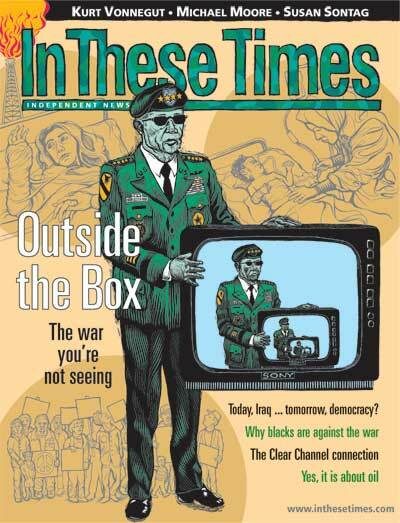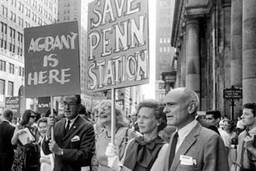
I believe we are at the threshold of a fundamental change in our popular economic thought,” Franklin Roosevelt announced during his 1932 campaign for the presidency. “In the future,” he predicted, “we are going to think less about the producer and more about the consumer.”
Why, at the very lowest point of the Depression, when factories were stalled, thousands of workers idle, and families on the brink of starvation, would a campaigning politician turn his attention to the private, individualistic sphere of the marketplace, and away from wages and production, the traditional engines of the American industrial economy?
Answering that question, as Lizabeth Cohen demonstrates in her fine new history A Consumer’s Republic: The Politics of Mass Consumption in Postwar America, requires understanding fundamental, pervasive and long-lasting shifts in the United States’ political economy and political culture. These transformations, while underway in the ’30s, would have their most pervasive effects in the 30 years after World War II, when Americans at all levels embraced the idea that their roles as public citizens were tangibly joined to their roles in the private marketplace as consumers.
The “consumer’s republic” is Cohen’s name not only for a time period— previously known as the high tide of national and urban liberalism, the age of the suburbs, or the boom years between the war and the oil crisis of the ’70s—but a “complex shared commitment.” This compact, or strategy—visible as such only in the historian’s hindsight, but agreed to by Democratic and Republican policymakers, business and labor leaders, and citizen activists—put the private mass consumption marketplace, supported by government resources and policy, at the center of postwar prosperity.
As a way of life, the consumer’s republic promised Americans not only a prosperous society, but a more equitable, democratic one in which the availability and abundance of goods would support and perpetuate basic and long-standing ideals of American freedom and equality. In other words, the consumer’s republic was one of the most encompassing utopian ideals yet offered to Americans. As such, it can be evaluated not solely by how successful it was in delivering its intended benefits, but by how pervasively it came to provide the terms in which people—even those left out of its munificence—understood themselves as private individuals and public citizens.
Cohen demonstrates how thoroughly acquisitive ideals usually judged to be private, or self-indulgent, questions of individual material desire became matters of public, political import. This differs from some recent accounts of consumption in at least one crucial way. Historian Gary Cross writes, for instance, that “consumerism—the understanding of self in society through goods—has provided, on balance, a more dynamic and popular, while less destructive, ideology of public life than most political systems in the twentieth century.”
Consumerism “won,” in his words, because it “concretely expressed” liberty and democracy by redefining them. Liberty became more than the abstract right promised by citizenship; it became the right to express oneself and realize personal pleasure through goods. Democracy no longer meant only equal rights or access to the political process, but the ability to share “with others in personal ownership and use of commodities.” According to Cross, it created social solidarities and opportunities for participation in national life that were felt to transcend even suffrage rights or political ideologies. The “world of goods” replaced the “republic of producers.”
————–
But Cohen’s consumers’ republic does not represent the decline of politics. Instead, it became the language through which public and political issues were understood and contested. Cohen is most adept at showing how this consumer’s republic was instituted and perpetuated by specific policies and interests and in particular landscapes.
As a purely economic fact, historians have determined that by the early 20th century, consumer demand had become the prime engine of American corporate capitalism. But that fact only gradually registered with observers at the time, and while Progressive-era consumers backed the political and economic reforms that brought anti-trust legislation, regulation of commodities producers, municipal utilities and election reform, it was not until the New Deal that consumption assumed pride of place in both the nation’s political economy and political culture.
As part of their campaign to shore up the corporate capitalism that the Depression imperiled, Roosevelt’s advisers recognized and encouraged grassroots consumer activism as a legitimate form of civic participation, even as they identified underconsumption as a major cause of the economic doldrums, and before they embraced Keynesian economic measures to stimulate consumer demand. With the war, consumption was irretrievably politicized, as the Office of Price Administration’s price controls set moral and monetary guidelines for consumer spending.
With the country needing every citizen to be what one wartime song called a “wise consumer,” new avenues of public legitimacy opened for marginalized people, particularly women and African Americans. Cohen contends that despite the iconic Rosie the Riveter image, women “were hailed most consistently as the standard-bearers of homefront consumerist citizenship.” They were expected to maintain what she calls “their own disciplined patriotic market behavior,” and to be vigilant for such responsible moral standards in others. When paired with their increased opportunities in defense industries, the war years, although tumultuous and unsure, emerge in Cohen’s telling as a high-water mark for women’s active participation in the nation’s public life.
————–
African-Americans faced a different challenge, but a similar opportunity. With the sudden importance of consumer-citizenship, blacks’ lack of equal access to restaurants, bars, public transportation, movie theaters, stores, pools and hotels became increasingly stark evidence of second-class citizenship. Such restrictions, Cohen points out, violated “both the assumed universality of citizenship and the supposed freedom of the free market,” but also opened up “new ground” upon which blacks could “stake their claim to fuller political participation.”
Blacks were “jim-crowed” all over the country—not just in the South—and discrimination in employment and housing, as well as unequal access to OPA price and rent protections, deepened the impact of segregation in public accommodations. But all across the country, blacks demanded equal access to public accommodations through sit-ins and demonstrations. These early skirmishes, the first of the modern Civil Rights Movement, demonstrated that lack of access to the full fruits of mass consumption was evidence of inferior political status.
With the end of hostilities, and postwar reconversion of industry imminent, business and industrial interests launched a concerted, and largely successful, campaign to kill price and rent controls. As a result, the consumer movement of the war years lost influence, and the loyal, sacrificing “consumer citizen” was gradually eclipsed by the new individualized “purchaser as citizen.” This ideal underwrote the full emergence of the consumers’ republic, as American interests of all political stripes promoted consumer spending as the one true road to equality and prosperity for all Americans. Individuals pursuing their many desires—houses, cars and consumer durables all bought on credit—juiced the economy, and the United States enjoyed several decades of prosperity.
But that prosperity was hardly shared equally, and the bulk of Cohen’s book is dedicated to revealing the various ways in which the mass consumer market “advantaged some social groups over others and created new inequalities while addressing old ones.” From a GI Bill that ignored women, slighted blacks, and gave middle-class men more opportunities than those offered to workers, to a new income tax code that favored married couples in which women did not work and rewarded homeowners and male breadwinners, the policy infrastructure of this republic underwrote division, not equality. Politicized black consumers did carry out, and eventually win, campaigns for access to public accommodations, but these victories came on the market’s terms, and thus without deeper changes in the culture and political economy of American racism.
————–
Cohen delivers her most compelling take on the mixed legacy of the consumers’ republic in two chapters on the suburbanization of housing and shopping. “The suburban home,” writes Cohen, was seen as the “quintessential mass consumer commodity, capable of fueling the fire of the postwar economy while also improving the standard of living of the mass of Americans.” Not only that, but when House Beautiful magazine declared that “our houses are all on one level, like our class structure,” ranch house suburbia figured as a Cold War weapon, an emblem of the classless abundance that the Soviet command economy couldn’t match.
This, of course, was a fantasy. While suburban development did open home-ownership to wage workers, and some early enclaves featured a mix of blue and white collars, the pursuit of higher property values soon resulted in a highly class-stratified suburban landscape. Federal mortgage subsidies underwrote housing construction in “stable” areas, and zoning laws ensured homogeneous communities. The same forces, buttressed by builders’ exclusion policies, vigilant white homeowners organizations, and stubborn inequality in schooling, kept suburbs even more segregated by race.
Downtown stores followed their customers to the suburbs, and by the late ’50s, retailers began to develop a new kind of shopping environment: the regional mall. These shopping centers were designed to provide community as well as commerce; their architects believed that they could build the town squares of suburbia. But not only did shopping centers locate in white, middle-class areas and functionally restrict access to those with cars, their management also reneged on the promises of public access, fighting a series of court battles to reserve the right to restrict speech on what was, after all, private property. The imperatives of the market meant dividing consumers along racial and class lines, and the result was that “the mass of Americans shared less and less common physical space and public culture.”
By the ’60s and ’70s, marketers began to follow these trends in housing and retailing by dividing what had once been the great leveling mass market into segments based on ever narrower categories of race, class, gender, age and lifestyle. Looking to “accelerate obsolescence,” as one department store magnate put it, and thus boost flagging profit margins, marketers and advertisers encouraged the very ethnic, gender and racial divisions plaguing the political culture at large.
————–
When a new consumer movement appeared, galvanized by Ralph Nader’s tussles with General Motors over automobile safety, it achieved a wealth of legislation protecting the buyer’s rights and health. But their boycotts and protests were premised on individual self-interest, and “became more a claim to personal entitlement than a commitment to society’s collective well-being.” This is what Cohen calls the “consumerization of the republic,” in which citizenship ideals have been entirely subsumed by consumer desires, economic and social inequality proliferate, and “the benefits long ago promised to all … increasingly became reserved for those who paid for them.”
Throughout the last century, consumer goods have given many a sense of freedom from the past or from closed worlds of family, ethnicity or region. But this freedom does not come without a price. Despite the social imagination its dream world offers, consumerism is an essentially private, atomizing experience. Or, more specifically, the social solidarity it offers is limited only to the private world of goods. Consumer capitalism ensures its own survival not just by the uneven development of expansion and imperialism, or by the minute divisions of market segmentation, but by a complementary, individual division within each person in which private imperatives always appear as the basis for the public good. It is a collective ethic of solipsistic pursuit.
It should be little surprise, then, why we look for the country’s health in housing starts or SUVs moved each quarter or why abstract measurements of “consumer confidence” carry so much portent for national woe or glee. This collective solipsism is both policy and ideology, the common language of elites and common-folk. It provides the supple web by which we are simultaneously held together and divided.
Why, at the very lowest point of the Depression, when factories were stalled, thousands of workers idle, and families on the brink of starvation, would a campaigning politician turn his attention to the private, individualistic sphere of the marketplace, and away from wages and production, the traditional engines of the American industrial economy?
Answering that question, as Lizabeth Cohen demonstrates in her fine new history A Consumer’s Republic: The Politics of Mass Consumption in Postwar America, requires understanding fundamental, pervasive and long-lasting shifts in the United States’ political economy and political culture. These transformations, while underway in the ’30s, would have their most pervasive effects in the 30 years after World War II, when Americans at all levels embraced the idea that their roles as public citizens were tangibly joined to their roles in the private marketplace as consumers.
The “consumer’s republic” is Cohen’s name not only for a time period— previously known as the high tide of national and urban liberalism, the age of the suburbs, or the boom years between the war and the oil crisis of the ’70s—but a “complex shared commitment.” This compact, or strategy—visible as such only in the historian’s hindsight, but agreed to by Democratic and Republican policymakers, business and labor leaders, and citizen activists—put the private mass consumption marketplace, supported by government resources and policy, at the center of postwar prosperity.
As a way of life, the consumer’s republic promised Americans not only a prosperous society, but a more equitable, democratic one in which the availability and abundance of goods would support and perpetuate basic and long-standing ideals of American freedom and equality. In other words, the consumer’s republic was one of the most encompassing utopian ideals yet offered to Americans. As such, it can be evaluated not solely by how successful it was in delivering its intended benefits, but by how pervasively it came to provide the terms in which people—even those left out of its munificence—understood themselves as private individuals and public citizens.
Cohen demonstrates how thoroughly acquisitive ideals usually judged to be private, or self-indulgent, questions of individual material desire became matters of public, political import. This differs from some recent accounts of consumption in at least one crucial way. Historian Gary Cross writes, for instance, that “consumerism—the understanding of self in society through goods—has provided, on balance, a more dynamic and popular, while less destructive, ideology of public life than most political systems in the twentieth century.”
Consumerism “won,” in his words, because it “concretely expressed” liberty and democracy by redefining them. Liberty became more than the abstract right promised by citizenship; it became the right to express oneself and realize personal pleasure through goods. Democracy no longer meant only equal rights or access to the political process, but the ability to share “with others in personal ownership and use of commodities.” According to Cross, it created social solidarities and opportunities for participation in national life that were felt to transcend even suffrage rights or political ideologies. The “world of goods” replaced the “republic of producers.”
————–
But Cohen’s consumers’ republic does not represent the decline of politics. Instead, it became the language through which public and political issues were understood and contested. Cohen is most adept at showing how this consumer’s republic was instituted and perpetuated by specific policies and interests and in particular landscapes.
As a purely economic fact, historians have determined that by the early 20th century, consumer demand had become the prime engine of American corporate capitalism. But that fact only gradually registered with observers at the time, and while Progressive-era consumers backed the political and economic reforms that brought anti-trust legislation, regulation of commodities producers, municipal utilities and election reform, it was not until the New Deal that consumption assumed pride of place in both the nation’s political economy and political culture.
As part of their campaign to shore up the corporate capitalism that the Depression imperiled, Roosevelt’s advisers recognized and encouraged grassroots consumer activism as a legitimate form of civic participation, even as they identified underconsumption as a major cause of the economic doldrums, and before they embraced Keynesian economic measures to stimulate consumer demand. With the war, consumption was irretrievably politicized, as the Office of Price Administration’s price controls set moral and monetary guidelines for consumer spending.
With the country needing every citizen to be what one wartime song called a “wise consumer,” new avenues of public legitimacy opened for marginalized people, particularly women and African Americans. Cohen contends that despite the iconic Rosie the Riveter image, women “were hailed most consistently as the standard-bearers of homefront consumerist citizenship.” They were expected to maintain what she calls “their own disciplined patriotic market behavior,” and to be vigilant for such responsible moral standards in others. When paired with their increased opportunities in defense industries, the war years, although tumultuous and unsure, emerge in Cohen’s telling as a high-water mark for women’s active participation in the nation’s public life.
————–
African-Americans faced a different challenge, but a similar opportunity. With the sudden importance of consumer-citizenship, blacks’ lack of equal access to restaurants, bars, public transportation, movie theaters, stores, pools and hotels became increasingly stark evidence of second-class citizenship. Such restrictions, Cohen points out, violated “both the assumed universality of citizenship and the supposed freedom of the free market,” but also opened up “new ground” upon which blacks could “stake their claim to fuller political participation.”
Blacks were “jim-crowed” all over the country—not just in the South—and discrimination in employment and housing, as well as unequal access to OPA price and rent protections, deepened the impact of segregation in public accommodations. But all across the country, blacks demanded equal access to public accommodations through sit-ins and demonstrations. These early skirmishes, the first of the modern Civil Rights Movement, demonstrated that lack of access to the full fruits of mass consumption was evidence of inferior political status.
With the end of hostilities, and postwar reconversion of industry imminent, business and industrial interests launched a concerted, and largely successful, campaign to kill price and rent controls. As a result, the consumer movement of the war years lost influence, and the loyal, sacrificing “consumer citizen” was gradually eclipsed by the new individualized “purchaser as citizen.” This ideal underwrote the full emergence of the consumers’ republic, as American interests of all political stripes promoted consumer spending as the one true road to equality and prosperity for all Americans. Individuals pursuing their many desires—houses, cars and consumer durables all bought on credit—juiced the economy, and the United States enjoyed several decades of prosperity.
But that prosperity was hardly shared equally, and the bulk of Cohen’s book is dedicated to revealing the various ways in which the mass consumer market “advantaged some social groups over others and created new inequalities while addressing old ones.” From a GI Bill that ignored women, slighted blacks, and gave middle-class men more opportunities than those offered to workers, to a new income tax code that favored married couples in which women did not work and rewarded homeowners and male breadwinners, the policy infrastructure of this republic underwrote division, not equality. Politicized black consumers did carry out, and eventually win, campaigns for access to public accommodations, but these victories came on the market’s terms, and thus without deeper changes in the culture and political economy of American racism.
————–
Cohen delivers her most compelling take on the mixed legacy of the consumers’ republic in two chapters on the suburbanization of housing and shopping. “The suburban home,” writes Cohen, was seen as the “quintessential mass consumer commodity, capable of fueling the fire of the postwar economy while also improving the standard of living of the mass of Americans.” Not only that, but when House Beautiful magazine declared that “our houses are all on one level, like our class structure,” ranch house suburbia figured as a Cold War weapon, an emblem of the classless abundance that the Soviet command economy couldn’t match.
This, of course, was a fantasy. While suburban development did open home-ownership to wage workers, and some early enclaves featured a mix of blue and white collars, the pursuit of higher property values soon resulted in a highly class-stratified suburban landscape. Federal mortgage subsidies underwrote housing construction in “stable” areas, and zoning laws ensured homogeneous communities. The same forces, buttressed by builders’ exclusion policies, vigilant white homeowners organizations, and stubborn inequality in schooling, kept suburbs even more segregated by race.
Downtown stores followed their customers to the suburbs, and by the late ’50s, retailers began to develop a new kind of shopping environment: the regional mall. These shopping centers were designed to provide community as well as commerce; their architects believed that they could build the town squares of suburbia. But not only did shopping centers locate in white, middle-class areas and functionally restrict access to those with cars, their management also reneged on the promises of public access, fighting a series of court battles to reserve the right to restrict speech on what was, after all, private property. The imperatives of the market meant dividing consumers along racial and class lines, and the result was that “the mass of Americans shared less and less common physical space and public culture.”
By the ’60s and ’70s, marketers began to follow these trends in housing and retailing by dividing what had once been the great leveling mass market into segments based on ever narrower categories of race, class, gender, age and lifestyle. Looking to “accelerate obsolescence,” as one department store magnate put it, and thus boost flagging profit margins, marketers and advertisers encouraged the very ethnic, gender and racial divisions plaguing the political culture at large.
————–
When a new consumer movement appeared, galvanized by Ralph Nader’s tussles with General Motors over automobile safety, it achieved a wealth of legislation protecting the buyer’s rights and health. But their boycotts and protests were premised on individual self-interest, and “became more a claim to personal entitlement than a commitment to society’s collective well-being.” This is what Cohen calls the “consumerization of the republic,” in which citizenship ideals have been entirely subsumed by consumer desires, economic and social inequality proliferate, and “the benefits long ago promised to all … increasingly became reserved for those who paid for them.”
Throughout the last century, consumer goods have given many a sense of freedom from the past or from closed worlds of family, ethnicity or region. But this freedom does not come without a price. Despite the social imagination its dream world offers, consumerism is an essentially private, atomizing experience. Or, more specifically, the social solidarity it offers is limited only to the private world of goods. Consumer capitalism ensures its own survival not just by the uneven development of expansion and imperialism, or by the minute divisions of market segmentation, but by a complementary, individual division within each person in which private imperatives always appear as the basis for the public good. It is a collective ethic of solipsistic pursuit.
It should be little surprise, then, why we look for the country’s health in housing starts or SUVs moved each quarter or why abstract measurements of “consumer confidence” carry so much portent for national woe or glee. This collective solipsism is both policy and ideology, the common language of elites and common-folk. It provides the supple web by which we are simultaneously held together and divided.
Sandy Zipp writes frequently on urban planning, history and culture for In These Times.






